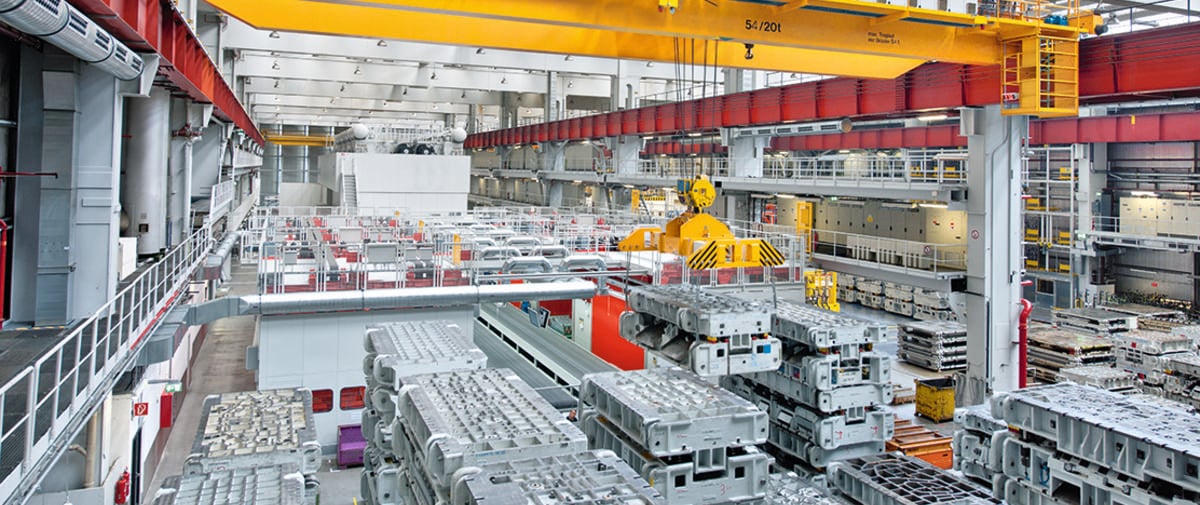Automotive production processes rely on performance and efficiency. Manufacturers develop and produce their products at the highest level and success comes from innovative technology and efficient processes. A warehouse management system can provide improved efficiency and productivity to help maximize performance. Here are seven reasons why you should consider a warehouse management system from Konecranes.
Improved inventory management
The Konecranes Warehouse Management System (WMS) for die warehouses offers advanced inventory management capabilities allowing you to accurately track and control your die inventory. Real-time visibility into the storage layout with die location and status helps you make informed decisions at any time. The storage layout view of the WMS is accessible not only on the shop floor but on office computers as well, so planning personnel can view it at any time. The WMS is a browser-based software solution that can be viewed on a computer, tablet or smartphone using your company intranet.
Increased efficiency and productivity
Implementing the Konecranes WMS for die warehouses lets you streamline warehouse operations and automate key processes such as die transfers and exchanges. This automation eliminates manual tasks, reduces handling time, and improves overall operational efficiency, leading to increased productivity and improved safety for operating personnel.
Optimized space utilization
The Konecranes WMS helps optimize space utilization within the die storage area (DSA). It leverages customer-tailored strategies and algorithms to determine the most efficient storage locations for dies, minimizing wasted space and maximizing storage capacity. This allows you to store more dies within the available space by automatically taking all possible storing restrictions into consideration.
Better demand planning
With the Konecranes WMS, you gain accurate and up-to-date information on die inventory, usage and trends. This data can be analyzed to make informed demand forecasts, so you have the right amount of dies available when needed. For example, if dies are in maintenance, it will be shown in the WMS. This allows planning personnel to coordinate maintenance processes with production schedules. By aligning die storage with demand, you can optimize your production processes and reduce stockouts.
Reduction in errors
Manual handling of dies can lead to errors—such as misplaced or damaged dies—which can disrupt production and incur costs. Implementing the Konecranes WMS minimizes the risk of errors by automating processes, providing accurate tracking, and delivering real-time alerts and notifications for potential issues. High precision and repeatability are key functions of WMS-driven, automated gripper crane operations. This helps reduce errors and enhances the overall reliability of die storage operations.
Integration with customer systems and data security
The Konecranes WMS can integrate seamlessly with your own systems such as HOST/MES (Manufacturing Execution System) to exchange data and streamline workflows. For example, production schedules, die movements and current inventory can be exchanged between the WMS and other systems. The integration enhances data accuracy, improves communication, and facilitates an automatically synchronized production process. Additionally, the Konecranes WMS provides data security by enabling authentication via Active Directory and single-sign-on (SSO). Its installation in a virtual environment allows for the highest isolation level for possible cyber-attacks.
Enhanced safety
Real-time monitoring of warehouse operations—including crane movements, storage areas, and system statuses—is provided by the Konecranes WMS. It can generate alerts and notifications for any safety concerns, such as access requests to restricted areas, abnormal equipment behavior, or potential hazards. These proactive notifications allow for timely intervention, helping to prevent accidents or incidents. In combination with the crane and ground control PLCs, the WMS implements an access system to conduct checks before executing any storage or retrieval operations. It can verify the compatibility of dies with specific storage locations, weight restrictions, or other safety criteria. The WMS user interface also provides guidance and instructions for safe operations and can offer visual cues, step-by-step instructions, or safety indicators to operators during tasks such as die exchanges.
Learn more about the Konecranes Warehouse Management System for die storage
